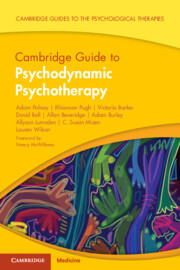Book contents
- Cambridge Guide to Psychodynamic Psychotherapy
- Cambridge Guides to the Psychological Therapies
- Reviews
- Cambridge Guide to Psychodynamic Psychotherapy
- Copyright page
- Dedication
- Contents
- Foreword
- Preface
- A Note from the Series Editor
- Acknowledgements
- Part 1: An Overview of the Model
- Chapter 1 An Historical Overview of Psychodynamic Psychotherapy
- Chapter 2 The Supporting Theory of Psychodynamic Psychotherapy
- Chapter 3 A Brief Description of the Empirical Basis of Psychodynamic Psychotherapy
- Chapter 4 An Outline of Psychodynamic Psychotherapy
- Part 2: The Model of Psychodynamic Psychotherapy into Practice
- Part 3: Application for Mental Health Presentations
- Part 4: Application of Psychodynamic Psychotherapy in Different Populations and in Different Settings
- Glossary of Terms
- Index
- References
Chapter 2 - The Supporting Theory of Psychodynamic Psychotherapy
from Part 1: - An Overview of the Model
Published online by Cambridge University Press: 25 August 2023
- Cambridge Guide to Psychodynamic Psychotherapy
- Cambridge Guides to the Psychological Therapies
- Reviews
- Cambridge Guide to Psychodynamic Psychotherapy
- Copyright page
- Dedication
- Contents
- Foreword
- Preface
- A Note from the Series Editor
- Acknowledgements
- Part 1: An Overview of the Model
- Chapter 1 An Historical Overview of Psychodynamic Psychotherapy
- Chapter 2 The Supporting Theory of Psychodynamic Psychotherapy
- Chapter 3 A Brief Description of the Empirical Basis of Psychodynamic Psychotherapy
- Chapter 4 An Outline of Psychodynamic Psychotherapy
- Part 2: The Model of Psychodynamic Psychotherapy into Practice
- Part 3: Application for Mental Health Presentations
- Part 4: Application of Psychodynamic Psychotherapy in Different Populations and in Different Settings
- Glossary of Terms
- Index
- References
Summary
This chapter provides an overview of current thinking regarding the supporting theory of psychodynamic psychotherapy. Rather than going through theoretical constructs in historical order of when each theory was proposed, they are presented as a composite of past and present thinking that the authors have found to be clinically relevant. It commences by describing theories on the early development of the infant and the creation of the internal world and object relations. The chapter them moves on to the issue of accommodating to the world as it is experienced by the infant, outlining circumstances leading to adaptive and less adaptive development. The chapter then outlines ‘core theory’ which covers more traditional psychodynamic concepts such as conflict, resistance, and defence mechanisms with an emphasis on projective identification. The role of this latter defence mechanism is linked with the theoretical constructs of transference and countertransference. There is a section on the narcissistic constellation in order to help the reader negotiate later sections in the book. Finally the chapter concludes with an introduction to theories as to how change is effected in psychodynamic psychotherapy.
Keywords
- Type
- Chapter
- Information
- Cambridge Guide to Psychodynamic Psychotherapy , pp. 18 - 50Publisher: Cambridge University PressPrint publication year: 2023



